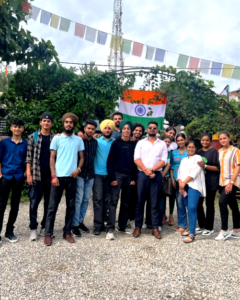HOLIDAY RENTALS DATES (EXAMPLE) : 10 – 22 JULY
| Name of property | Location | Features | Disadvantages | Booking details |
|---|---|---|---|---|
| (1)………………….. | – Rural – Surrounded by (2)…………….. | – Apartment – Two bedrooms – Open plan | Distance from (3)……………….. | www.(4)……….com |
| Kingfisher | – Rural – Next to the (5)………….. – Nice views | – House – Three bedrooms – (6)…………rooms – Living room – Kitchen | Expensive | phone the owner (01752669218) |
| Sunnybanks | – In a village – Next to the (7)……………. | – House – Has private (8)………………….. | No (9)…………………… | Contact the (10)………………… |
(1) (2)
(3) (4)
(5) (6)
(7) (8)
(9) (10)
Part 2: Questions 11-14
Choose the correct letter A, B or C.
11. According to the speaker, why is it a good time for D-I-Y painting?
A there are better products available now
B materials cost less than they used to
C people have more free time than before
12. What happened in 2009 in the UK?
A a record volume of paint was sold
B a large amount of paint was wasted
C there was a major project to repaint public buildings
13. What does the speaker say about paint quantity?
A it is not necessary to have exact room measurements
B it is better to overestimate than to underestimate
C an automatic calculator can be downloaded from the internet
14. What does Community RePaint do?
A it paints people’s houses without payment
B it collects unwanted paint and gives it away
C it sells unused paint and donates the money to charity
Questions 15 and 16
Choose TWO letters A-E.
What TWO pieces of advice does the speaker give about paint?
A do not buy expensive paint
B test the color before buying a lot
C choose a light color
D use water-based paint
E buy enough paint for more than one application
Questions 17 and 18
Choose TWO letters A-E.
What TWO pieces of advice does the speaker give about preparation?
A replace any loose plaster
B don’t spend too long preparing surfaces
C use decorators’ soap to remove grease from walls
D wash dirty walls with warm water
E paint over cracks and small holes
Questions 19 and 20
Choose TWO letters A-E.
What TWO pieces of advice does the speaker give about painting?
A put a heater in the room
B wash brushes in cold water
C use a roller with a short pile
D apply paint directly from the tin
E open doors and windows
Part 3: Questions 21-26
Choose the correct letter A, B or C.
21. Why is Matthew considering a student work placement?
A he was informed about an interesting vacancy
B he needs some extra income
C he want to try out a career option
22. Which part of the application process did Linda find most interesting?
A the psychometric test
B the group activity
C the individual task
23. During her work placement, Linda helped find ways to
A speed up car assembly
B process waste materials
C calculate the cost of design faults
24. Why did Linda find her work placement tiring?
A she was not used to full time work
B the working hours were very long
C she felt she had to prove her worth
25. What did Linda’s employers give her formal feedback on?
A engineering ability
B organizational skills
C team working
26. What was the main benefit of Linda’s work placement?
A improved academic skills
B an offer of work
C the opportunity to use new software
Questions 27-30
What does Linda think about the books on Matthew’s reading list?
Choose FOUR answers from the list and write next to questions 27-30.
Options
A helpful illustrations
B easy to understand
C up to date
D comprehensive
E specialized
F useful case studies
Books
27. The Science of Materials
28. Materials Engineering
29. Engineering Basics
30. Evolution of Materials
Part 4: Questions 31-40
Complete the notes below. Write NO MORE THAN TWO WORDS for each answer.
Animal hides – two types
Parchment
Sheep skin: white in color and (31)
Greasy – writing cannot be erased so often used for (32)
Vellum
Calf skin: most popular for prestigious work because you can get (33) lettering
Preparation of hides:
• Treated in berries of lime – where this was not available skins were (34) (removed hair)
• Stretched tight on a frame
• Scraped to create same (35)
• Vellum was (36) – for correct color
Genetic testing – finding origins
Previously – analysed handwriting and (37) used by the writer
Now – using genetic data from ‘known manuscripts’ to create a (38)
Uses of new data
Gives information on individual books
Shows the (39) of the book industry
Helps define (40) in medieval period








